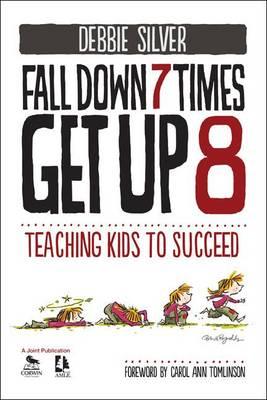The Amazing Power of Teachers’ Words
Dr. Debbie Silver is an award-winning educator, 30 year veteran of the classroom, staff development instructor, and university professor. Her numerous recognitions include being named the Louisiana State Teacher of the Year. She’s taught on almost every grade level.
This article is adapted from her book Fall Down Seven Times, Get Up Eight: Teaching Kids to Succeed (Corwin Press, 2012). Read our MiddleWeb review here.
by Debbie Silver
I grew up hearing the adage, “It’s not so much about what you say as how you say it.” I generally agreed with that idea. As a positive, enthusiastic teacher I often used effusive praise and all kinds of “rah-rah” exclamations to boost my students’ self-esteem and willingness to participate. I bubbled out meaningless phrases like, “You are so smart!” “You’ve got a natural talent!” “You are the absolute best ever!” with little regard to whether or not these particular phrases did anything to enhance self-efficacy in my learners. I just wanted them to feel good.
Whenever my students failed I would quickly try to cover it up or minimize its importance so they wouldn’t lose any confidence by saying things like, “Oh, that test was really hard,” or “Well, maybe science is not your thing.” However, through my studies on the art and science of engaging learners I have come to believe that our choice of words is an often overlooked critical factor for inspiring learners to be independent, self-motivated students.
It really IS about what you say
To understand the damaging effect of inappropriate word choices, it is important to examine a psychological concept called attribution theory. Bernard Weiner (1980) asked subjects why they were or were not able to achieve certain goals. He recorded all their responses. He was able to sort the participants’ responses into what later came to be classified as one of four groups:
• Task (“That assignment was so easy.” “The textbook was way too hard to read.”)
• Luck (“I guessed correctly about what to study.” “She only asked about stuff I didn’t know was going to be on the test!”)
• Innate Ability or Talent (“Being good at sports just runs in my family.” “I can’t draw anything – never could and never will.”)
• Effort (“I studied really hard, and I was prepared this time.” “I didn’t put the time into this assignment I needed to.”)

The singular attribute a student can influence is the fourth one, effort. Thus, effort is the only factor that can be controlled by the learner. The ramifications of this research are essential to consider when choosing our classroom comments.
When teachers praise innate talent and/or luck, we are basically diminishing the student’s role in her own success. If we allow kids to dismiss their low achievement as a result of the task difficulty, we are complicit in “letting them off the hook.” After all, they cannot control their genetic make-up, fate, or how hard or how easy the undertaking is.
What is important about understanding attribution theory is that adults can use it to help children accept responsibility for their successes and failures. Students can learn how to empower themselves rather than feel entitled or victimized. They can do this by attributing their success or lack of it to something they can control – their effort. Our feedback needs to address only things over which they have control – their choices and their effort.
Effective Feedback
Effective feedback starts with carefully selecting words that are honest, specific, nonjudgmental, and specifically chosen to help the student figure out how to get better. It should inform them about their progress. It should not judge, label, accuse, excuse, or even praise. It provides instructive knowledge that will enhance the student’s performance.
It is important to remember that inefficient learners often have no idea what the adults mean when we say, “you just need to work harder.” We need to provide modeling and incremental steps to help them understand the preparation we want them to use. We have to guide them with specific words towards helpful techniques for practicing efficiently and effectively.
Students thrive on individual, specific attention from caring adults. It is one of the greatest gifts we can give them.
Additionally, adults often fail to realize that some of the most effective feedback does not come in the form of statements but rather as questions. Learners appreciate having a fully focused non-judgmental adult interested in their work. The teacher can ask questions such as, “Ramon, how did you decide on that particular design for you paper airplane?” “If you could change one thing about your design, what would it be?” “Can you walk me through your thought process?” Students thrive on individual, specific attention from caring adults. It is one of the greatest gifts we can give them.
Effective and Ineffective Praise
Here are some examples of ineffective praise — and of praise that promotes appropriate attribution.
Ineffective: Restricted to global positive reactions. “Good job!” “Awesome!” “Number One!” “You Rock!”
Effective: Specifies the particulars of the accomplishment. “You finished the exercise on time with 90% accuracy.” “Your project meets the highest standards on 3 of the 5 criteria on the rubric.” “You turned in your assignment every day this week without having to be reminded.”
Ineffective: Shows a bland uniformity that suggests a conditioned response made with minimal attention. “Oh, that’s good.” “It’s fine.” “Uh-huh.” “Way to go.” “Okay.” “Awesome.”
Effective: Shows spontaneity, variety and other signs of credibility that suggest clear attention to the student’s accomplishment. “The details you included in your theme made me feel like I was right there.” “The way you played that ball showed some quick thinking.” “That example you just gave was one I never would have thought of, and you’re exactly right.”
Ineffective: Provides no information at all or gives students information about their status. “Okay, turn it in.” “Yes, I see you’re done.” “Don’t worry, you’re fine.” “It’s acceptable.”
Effective: Provides information to the students about their competence or the value of their accomplishments. “This paper clearly demonstrates you’ve attained mastery in this concept. That is something to be proud of!” “In your group today I noticed it was you who smoothed over the argument and got things back on track.” “It seems like you’re the one everyone turns to with their computer problems. Thanks for sharing your skills with your classmates.”
Ineffective: Orients students toward comparing themselves with others and thinking about competing. “Can you make that a little more like Charlotte’s?” “You’re not keeping up with the other G/T students.” “You still didn’t make the top score in the class.”
Effective: Orients students toward better appreciation of their own task-related behavior and thinking about problem solving. “Do you realize you just exceeded your own personal best record?” “Show me how you solved that difficult problem.” “Let’s take a look at the progress you’ve made these past few weeks.”
~ adapted from Brophy, JE (1981)
Tricky business
Communicating high expectations is a tricky business. The subtleties of our words are not lost on students, and those words carry very strong messages. While it is indeed desirable to let students know we believe in them and their abilities, it is equally important that we use the appropriate words to direct their attention to attributes that help them build a sense of self-efficacy and self-motivation.
We need to choose our words carefully and use effective feedback to help students learn to succeed. While middle grades teachers always need to be mindful of the manner in which we communicate with our impressionable young learners, we must also be aware that what we choose to say is important and part of the teaching act.
Think twice before you speak, because your words and influence will plant the seed of either success or failure in the mind of another. — Napoleon Hill
Learn more about the research behind attribution theory in this excerpt from Silver’s book.
REFERENCES
Ames, C.A. (1990). Motivation: What teachers need to know. Teachers College Record, 91, 409-421.
Brophy, J.E. (1981). Teacher praise: A functional analysis. In Review of Educational Research, Spring, 5-32.
Silver, D. (2012). Fall Down 7 Times, Get Up 8: Teaching Kids to Succeed. Thousand Oaks, CA: Corwin Press/Columbus, Ohio: AMLE.
Weiner, B. (1979). A theory of motivation for some classroom experiences. Journal of Educational Psychology, 71. 3-25.
Weiner, B. (I980). A cognitive (attribution)-emotion-action model of motivated behavior: An analysis of judgments of help-giving. Journal of Personality and Social Psychology, 39 (2), 186-200.
Debbie Silver, Ed.D. is a former Louisiana Teacher of the Year, a popular speaker, and the author of five best-selling books including the new 2nd Edition of Deliberate Optimism: Still Reclaiming the Joy in Education with Jack Berckemeyer (Corwin, 2023). Read our review.
Her other books include Teaching Kids to Thrive: Essential Skills for Success with Dedra Stafford (Corwin, 2017) and a later edition of Fall Down 7 Times, Get Up 8 (2nd ed.): Raising and Teaching Self-Motivated Learners (Corwin, 2021).
Debbie’s many MiddleWeb articles include the widely read “Empowering Our Kids to Motivate Themselves.” Follow her on X-Twitter and visit her website for more resources and information about her speaking and PD services.






























1 Response
[…] Author Debbie Silver examines effective feedback, motivational praise, and the need for teachers to choose their words & questions in ways that encourage effort. […]